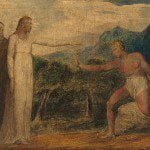
First of all, I wish a happy Fourth of July to everybody out there. Even to those for whom it isn’t Independence Day. Perhaps especially to our British cousins, who gave us this holiday. And, of course to our Canadian neighbors, our friends in Greenland, our other neighbors in Panama to the south, and my relatives in Denmark, who may all soon be celebrating it with us, whether willingly or not!
Since the website of the Interpreter Foundation is essentially dormant and since all of the Foundation’s resources are currently devoted to my gourmet dining out and my luxurious lodging, I can perhaps be forgiven for almost missing the three new items that have appeared on the Foundation’s website since roughly noon yesterday. Who would have expected them? But I apologize. And I attempt to catch up below. Here are the three most recent entries on the website:
“Reconciling Evolution by Faith or Framing?” written by Jacob Billings
Review of Jamie L. Jensen, Steven L. Peck, Ugo A. Perego, and T. Benjamin Spackman, eds. The Restored Gospel of Jesus Christ and Evolution. Provo, UT: College of Life Sciences, Brigham Young University, 2025. 272 pgs.
Abstract: This review critically evaluates The Restored Gospel of Jesus Christ and Evolution, a multi-author volume that seeks to harmonize evolutionary science with the doctrines and theological framework of The Church of Jesus Christ of Latter-day Saints. While the book offers valuable pedagogical models, personal narratives, and historical context for addressing faith-science tensions, it exhibits notable limitations. Chief among these is an oversimplified distinction between belief and acceptance in scientific discourse, a lack of engagement with legitimate critiques of evolutionary theory, and insufficient resolution of scriptural and theological tensions. Although the collection succeeds in promoting dialogue and reducing conflict among religious students and educators, its rhetorical bias toward scientific consensus and avoidance of unresolved doctrinal issues ultimately weakens its reconciliatory potential. The volume is a meaningful step forward but leaves substantial theological and epistemological work unfinished. The volume’s most commendable aspiration lies in its effort to model epistemological reconciliation—not merely tolerance—between scientific and religious modes of knowing, a theme that could benefit from further theological exploration.
“Anachronisms: Accidental Evidence in Book of Mormon Criticisms: Preface,” written by
[Editor’s Note: We are pleased to present the preface from a book entitled Anachronisms: Accidental Evidence in Book of Mormon Criticisms. It is presented in serialized form in this volume of Interpreter: A Journal of Latter-day Saint Faith and Scholarship.]
Seek Ye Words of Wisdom: ““A Still Small Voice”: Three Permutations of Qôl Dĕmāmâ Daqqâ in the Book of Mormon,” written by Matthew L. Bowen
Part of our book chapter reprint series, this article originally appeared in Seek Ye Words of Wisdom: Studies of the Book of Mormon, Bible, and Temple in Honor of Stephen D. Ricks, edited by Donald W. Parry, Gaye Strathearn, and Shon D. Hopkin. For more information, go to https://interpreterfoundation.org/books/seek-ye-words-of-wisdom/.
“Four passages in the Book of Mormon that describe the physical or audial characteristics of the voice of God—1 Nephi 17:45; Helaman 5:30–31; Helaman 5:46–47; and 3 Nephi 11:3–7—all quote or allude to the description in 1 Kings 19:12 of “a still small voice” (KJV). Modern English Bible translations differ greatly in how they render the underlying Hebrew phrase qôl dĕmāmâ daqqâ: e.g., “a sound of sheer silence” (NRSV), “a light silent sound” (NAB), “a faint murmuring sound” (REB), “a gentle whisper” (NIV), etc.”

(Wikimedia Commons public domain image)
Sigh. I’m under the weather today — two weeks of it, now! — and, so, probably won’t be doing a whole heck of a lot to celebrate Independence Day. But there’s always fun of some sort to be had:
A critic of the Church of Jesus Christ of Latter-day Saints, wishing today to rebut Matt Roper’s very recently published work on purported anachronisms in the Book of Mormon, first attempted to do so by raising the issue of early Latter-day Saint plural marriage. It’s not a cogent response, of course. In fact, it’s rather like crying out “Squirrel!” It’s a fallacy of irrelevance, an attempt at distraction or deflection. When he realized that his ploy had been recognized for what it was and, thus, had failed, the critic immediately shifted gears:
Google the word I’jaz. The Muslims have the same argument about the Quran. No human could duplicate it so it must be from God. The whole farm boy thing is crazy. The farm boy was more educated than the tent dwelling Nephi. So either Nephi or jospeh wrote it. Both uneducated. Who wrote the doctrine and covenants? Oh yeah JS. He is good a pretending to speak in the voice of God.
This is also an irrelevancy and an attempt at distraction, as it doesn’t address Matt Roper’s argument even indirectly.
But I don’t need to Google the word اَلْإِعْجَازُ. It’s true, of course, that many Muslim apologists have argued for the Qur’an’s “inimitability” — although the famous twentieth-century Egyptian Muslim writer and intellectual Taha Hussein thought the argument at least slightly misguided — but I’m happy to quickly point out at least a few of the significant differences between the Qur’an and the Book of Mormon with regard to the concept that it represents.
First, though, three stipulations upon which I won’t bother to expand here:
- I disagree that “The whole farm boy thing is crazy.” I think it fairly obvious that creation of the Book of Mormon was likely beyond the literary ability of the young Joseph Smith.
- I also disagree with the critic’s assertion that “The farm boy was more educated than the tent dwelling Nephi.” Assuming the historicity of Nephi for purposes of argument, he seems to have grown up in a wealthy family and, by the standards of the seventh/sixth century before Christ, to have received a fine education. (See 1 Nephi 1:1, for starters.) Temporarily living in a tent in no way entails a lack of education on his part.
- I’m inclined to believe — certainly I’m open to the belief — that at least some degree of divine inspiration undergirds the Qur’an, and (by the way, I taught semester-length college classes on the Qur’an for many years, both in English and in Arabic) I regard it as a remarkable piece of literature.
The “inimitability” of the Qur’an is commonly believed by Muslims to reside chiefly in three aspects of it: (1) its allegedly incomparable style, (2) the unique knowledge that is supposedly represented in it, and (3) its being beyond the ability of the Prophet Muhammad to have composed. I don’t really hear Latter-day Saints claiming (1a) stylistic uniqueness for the Book of Mormon. Rather, many of their arguments for its authenticity tend to focus on (2a) “things in it that Joseph couldn’t have humanly known,” and (3a) its purported transcendence of Joseph’s literary ability.
They are very different books. Within the Latter-day Saint scriptural canon, the Qur’an most resembles neither the Bible nor the Book of Mormon, but the Doctrine and Covenants. Like the Doctrine and Covenants, it is an anthology of discrete revelations (sūrahs; سُورَة, pl. سُوَر) that were received over nearly a quarter of a century (specifically, between AD 610 and AD 632, compared to Joseph Smith’s prophetic career, which lasted from 1820 to 1844). And I’m unaware of anybody who claims that the overall complexity of the Doctrine and Covenants puts it beyond Joseph’s capacity.
What is argued — and, in my judgment, plausibly so — is that the Book of Mormon’s considerable length, coupled with its internal consistency and complexity — which increase exponentially with a document’s increasing length — and the speed of its dictation (within less than two and a half months, as opposed, say, to twenty-two years) and its recipient’s semi-literacy, makes accounting for its creation difficult on solely natural grounds.
Much more could obviously be said on this topic, but I’m out of time for the moment.











